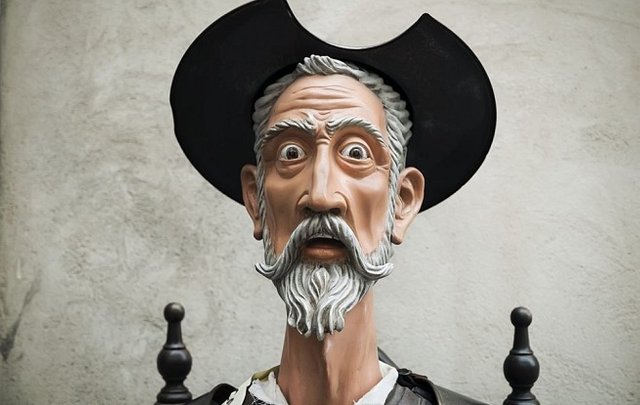About Cervantes and his book "Don Quixote" /part 6/
Sancho's fat stomach, his appetite and craving, are basically deeply carnival; his striving for abundance and completeness at its core still does not have a private-egoistic and distinct character, that is the pursuit of the universal abundance. Sancho is a direct descendant of the ancient scumbag demons of fertility, the figures of which we see, for example, on the famous Corinthian vases. Therefore, in the images of eating and drinking, the people-feast, the holiday moment is still alive here. Sancho's materialism - his bourgeois, his appetite, his heavy feces - this is the absolute bottom of Grotesque realism, that is the cheerful body grave, the gut, the earth, dug for Don Quixote's distinct, abducted and lifeless idealism; in this tomb, "the knight of the sorrowful image" seems to have to die to be born again, better and greater; it is a material and bodily corrective to the individual and abducted-spiritual claims; besides this, it is a people's corrective of laughter to the one-sided seriousness of these spiritual claims (the absolute slumber always laughs, it is the birth and the laughing death). Sancho's role in terms of Don Quixote can be compared to the role of medieval parodies in terms of high ideology and cult, with the role of shouting about the serious ceremony ...
The rejoicing cheerful beginning, but weakened, still exists in the landing images of all these mills, the pubs / castles, the herds of sheep and sheep / the knights' army, the pubs / the owner of a castle, the prostitutes / noble ladies. All of this is a typical grotesque carnival, featuring the battle in the kitchen and pirate, the gun and the helmets - in kitchen utensils and shaving rags, the blood - in the wine / episode with the fight with the wine drums / etc. This is the first carnal aspect of the life of all these material-body images on the pages of the Cervantes novel. Evolution in Relationships Don Quixote-Sancho Pansa: The need for unity is already dictated by the existent ever - in classical Greece - a precedent of a harmonious unity between the personality and the society. But not in reaching, but in endless self-consciousness is the beauty typical of New Age. This is the beauty of disharmony, the eternal quest for unity. That is why the category is not the same as in antiquity, but in this category there is a specific aesthetic category. Therefore, unity is achieved not as a roundness, consistency of the image, not in the connection of the principle, not in the periphery, not in the denomination, but in the nipple, in the starting point - as the unity of the artistic problem, the internal contradiction. The unity and integrity of Don Quixote is not that in both his volumes there is just as much artistic material as needed: there could have been fewer and more interstitial novels, episodes, and in the unity of contradiction, artistic problem, the situation through which life is seen: Don Quixote - Sancho Pansa, the illusion of the reality and the reality of the illusion ...
Don Quixote is not an immanent comic, he is comic as a delayed function of conditions that have lasted for at least two centuries .. This is the insanity of the madman but lies in his mind and wisdom ... As in Hamlet's madness, and in Don Quixote's madness there is a system, and where there is a system there is reason, because the system is always the result of reason. Don Quixote is not a mixture of reason and madness. He is wise in foolishness, he is wise in madness. Don Quixote's madness turns the imperfection of the world into the perfection of the ideal. Unlike Hamlet, Don Quixote does not thoroughly examine acts, evidence, and witnesses. He knows his debt, the few simple rules of life he applies most often where their application is pointless. Don Quixote must constantly prove to others and to himself that he despises all sorts of dangers - he does so not to conceal an inner weakness that he does not really know, and not to satisfy a vain ambience that is really alien to him, to realize absolute independence and the absolute freedom of his spirit . Don Quixote is at home and must die. He can not live like an Alonso Kehana man who has already been Don Quixote. In fact, Sancho Panza is not an antipod of Don Quixote, and his double, alter ego. The wandering armor is completely worthy of the wandering knight. The differences between Sancho Pansa and Don Quixote are differences in the phenomenon, in the detail, but not in the principle.

Excellent story.I like it
very nice :)
You have recieved a free upvote from minnowpond, Send 0.1 -> 10 SBD with your post url as the memo to recieve an upvote from up to 100 accounts!